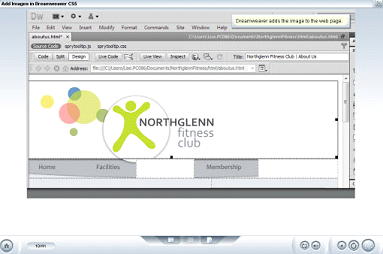Adobe Dreamweaver CS5 Training Course
 Adobe Dreamweaver CS5 is a versatile web site development application, suitable for personal and business development environments. With over 12 hours of training, this course explores the concepts of creating a new site in Dreamweaver CS5, including configuring site properties and application preferences, adding content, and manipulating text. It offers a look at the major interface elements of Dreamweaver CS5, including Live View and workspaces, is also provided. Adobe Dreamweaver CS5 is a versatile web site development application, suitable for personal and business development environments. With over 12 hours of training, this course explores the concepts of creating a new site in Dreamweaver CS5, including configuring site properties and application preferences, adding content, and manipulating text. It offers a look at the major interface elements of Dreamweaver CS5, including Live View and workspaces, is also provided.Our Dreamweaver Training for CS5 course takes you step by step from the beginner level to the advance level, along with interactive exercises Target Audience The audience is targeted for anyone needing to learn how to use Dreamweaver without any experience of any version of Dreamweaver. Students can be expected to have basic computing and word-processing skills, familiarity with web terminology and Internet navigation, familiarity with HTML, and experience working in a Microsoft Windows or Apple Macintosh environment. Expected Duration (hours) 12.5 Adobe Dreamweaver CS5 Course Outline • Setting up a Site and Adding Content • Adding Links and Images • Tables, Accessibility, and Standards • Reusing Content • Creating Interactive Web Pages • Cascading Style Sheets Adding Links and Images i • Add links to a page • Create named anchors • Create e-mail links • Create links in a given scenario, • Add an accessible image to a page • Add an image map to a web page • Edit an image in Dreamweaver • Optimize an image • Insert an image created in Photoshop into a web page • Add a resource using the Assets panel • Use the Assets panel favorites list • Add Flash movies to a web page • Add Flash videos to a web page • Add and optimize images • Add Flash movies to a page Tables, Accessibility, and Standards • Create a table • Modify a table's properties • Add information to a table • Import tabular data • Export tabular data • Format a table • Build and modify a table • Set accessibility preferences • Check target browser compatibility • Compare how web pages display in various browsers • Modify accessibility settings for a site • Check a web site for browser compatibility Reusing Content • create a web page template • create a new page from a template • create library items • modify library items • use templates and library items • create framesets • identify the advantages and disadvantages of using frames • add content to a frameset • create hyperlinks in a frameset • add noframes content create a frameset and add content to it • Creating Interactive Web Pages • Create a form • Add checkboxes and radio buttons • Add list items and menu options • Add submit and reset buttons • Configure a form to work with a cgi script • Recognize how a cgi script works • Add a spry widget • Build a form • Adding behaviors to web pages • Recognize the functions of behaviors • Modify a behavior • Recognize how to swap images on a web page • Add interactivity to a web page • Add a jump menu to a page • Add a spry effect to a web page • Add spry widgets to a web page • Add built-in interactive elements to a web page Cascading Style Sheets • Identify the features and functions of Cascading Style Sheets • Set CSS style preferences • Recognize the features of the CSS Styles panel • Create and attach an external style sheet • Recognize the functions of various style selectors • Create a style rule • Edit a style rule • Edit a style sheet • Export a style sheet • Create, attach, and edit an external style sheet in a given scenario • Create a new page with a CSS layout • Customize a CSS layout • Recognize the CSS positioning properties • Use AP Divs to position elements r • Review the CSS layout of a web page using CSS Inspect • Use class styles • Create advanced style rules • Identify when you would apply advanced style rules • Apply advanced CSS techniques to a web page  Whether you are learning to create a website, maintain and edit an existing website, or just want to learn Dreamweaver CS5 and various types of cascading style sheets and style rules, this course will provide you with the skills necessary to help build an accessible web site that complies with web standards.. With our interactive exercises, the actual software is not required to be running on your computer. Review is easy with the option to do searches and print transcripts of each lesson. Whether you are learning to create a website, maintain and edit an existing website, or just want to learn Dreamweaver CS5 and various types of cascading style sheets and style rules, this course will provide you with the skills necessary to help build an accessible web site that complies with web standards.. With our interactive exercises, the actual software is not required to be running on your computer. Review is easy with the option to do searches and print transcripts of each lesson. |
Copyright © 2011 - All Rights Reserved - GIMIT.NET











